1. Introduction
Renaissance has brought a historic turning point in many countries, especially the Renaissance movement in European countries, a landmark movement in the history of European culture and even the world culture. Western Renaissance is an intellectual and cultural movement that occurred between the 14th century and the 16th century, the emergence of the Renaissance was following with the "dark age" of the height of prosperity of Greek and Roman antiquity, which is a representation of the rebirth of science and culture [1]. Science is the field of study that verifies the world around people through experimentation and observation, it involves various fields, including natural science, math, geometry, anatomy, and other aspects [2]. The Renaissance's influence on the sciences can be reflected in many ways, especially in the science factors in the arts. Art can be regarded as the expression form of creativity or imagination, people could represent their feeling, artistic talent, and experimentation through music, painting, dance, and other artwork. Science and Art are two separate disciplines; however, a wealth of early documents showed that science elements involved in the artwork, they often indistinguishable from each other [3]. This paper would commit to explaining the intimate connection between science and art in the context of the Renaissance by discussing the mathematics and composition skills in the portrait painting Mona Lisa by Leonardo da Vinci and the tempera painting Annunciation by Sandro Botticelli. Firstly, the essay would emphasize the importance of art to science. Secondly, there will be an introduction to the history and nature of the Golden ratio. Thirdly, the method to prove the science in art and their connection is to explain the mathematics ratio in the Mona Lisa and Annunciation.
2. The Importance of Art to Science
There is a lot of evidence that could support that art is necessary for science. Art involves creativity or imagination, it can express professional competence, beauty, emotion, or conceptual ideas in different forms. An article from Anna Powers contributed that the creativity and imagination that are brought by art are needed by scientific breakthroughs, and art would become a way of expressing scientific knowledge, which ultimately promotes art and science are closely related [4]. Peter W. Parshall and David Landau proposed that the illustrations could serve as standard references for scholars in laboratories in many fields, and accurate visual representation could be a highly specialized form of observation [5]. From the perspective of the development of art, it is based on the use of mathematics to a large extent [6]. The mathematics here mainly refers to the knowledge related to geometry, picture structure, line perspective, and dynamic graphics. The Renaissance artists had already made great contributions to human knowledge, it should be mentioned that the distinction between art and science during the Renaissance was not as clear as it is now, many artists sometimes create works that involved both art and science [7]. Artists are also absolutely authoritative in the production and utilization of certain knowledge. For instance, the Italian Renaissance Leonardo Da Vinci promoted the study of anatomy by dissecting dead animals. He was asked to adjust and draw manuscripts for hydraulic engineering. Leonardo also researched and practiced the design of large crossbows and other large weapons [8]. In general, literary humanists have promoted the interaction of the two disciplines, invented mathematical perspectives through art, made it possible to depict physical space accurately and realistically, revive various classics, and have expanded rapidly the range of human knowledge.
3. The Golden Ratio
The golden ratio in mathematics and the arts can also be called the golden section or divine proportion. The ratio refers to the ratio of the long side to the short side is 1:1.618 or the Greek letter ф, and it was first proposed in ancient Greece by mathematician Pythagoras and the "Father of Geometry" Euclid [9]. The golden section has strict proportion, rich artistry, and harmony, it can arouse people's aesthetic feelings. The ratio is considered the most aesthetically pleasing ratio to the eyes and the most ideal ratio in architecture and art [10]. The ancient Greeks recognized the nature of 'division' before the Renaissance and were eventually reduced to 'section', which refers to 'ratio' nowadays [11]. The Greeks also noted that the golden ratio provided the most aesthetically pleasing proportion of rectangular edges, and this concept was reinforced during the Renaissance [12]. Meisner proposed that the golden section was generally favored and used by Renaissance artists [13]. For example, during the Renaissance time, painters like Leonardo da Vinci and Michelangelo Buonarroti showed the use of the golden ratio in the composition of paintings and the structure of figure sculptures, and architect Leon Battista Alberti recombined the basic shapes of circles and squares in proportion to find the golden ratio of building.
3.1. Mathematics Ratio in the Mona Lisa
Mona Lisa is a half-length portrait of Leonardo Da Vinci, a famous Italian Renaissance painter, natural scientist, and engineer [14]. This artwork is an oil painting and has been on permanent display at the Louvre Museum in Paris since 1797. There is much debate about the painting's creative time, some experts suggested it was painted between 1503 and 1506, but some argued that Leonard painted it in 1513 [15]. Mona Lisa is not only considered one of the most valuable paintings in the world but has also been described as the most mystical [16]. Mona Lisa's smile has been described as the "eternal smile", there are mystical, elegant, and engaging elements involved in her smile [17]. No matter what angle people look at the Mona Lisa, they will find Mona Lisa in the painting smiling at them. Many researchers are willing to attribute the reason why Mona Lisa's smile is mystical and attractive to the use of the golden ratio in the structure of the Mona Lisa, the golden ratio of 1:1.618 is maintained in many parts of Mona Lisa [18]. There is no direct evidence supporting that Leonardo consciously used the ф in the Louvre Mona Lisa. However, Italian mathematician Luca Pacioli published a three-volume treatise about the golden ratio in 1509. Leonardo provided illustrations and some views for those treatises as Pacioli’s close friend, which makes some scholars speculate some of Leonardo's paintings are embedded with a golden ratio [19]. Additionally, many articles claim that the ratio of 1:0.618 is embedded in the Louvre Mona Lisa with the composition proportion of rectangle, triangle, and spiral [15-17].
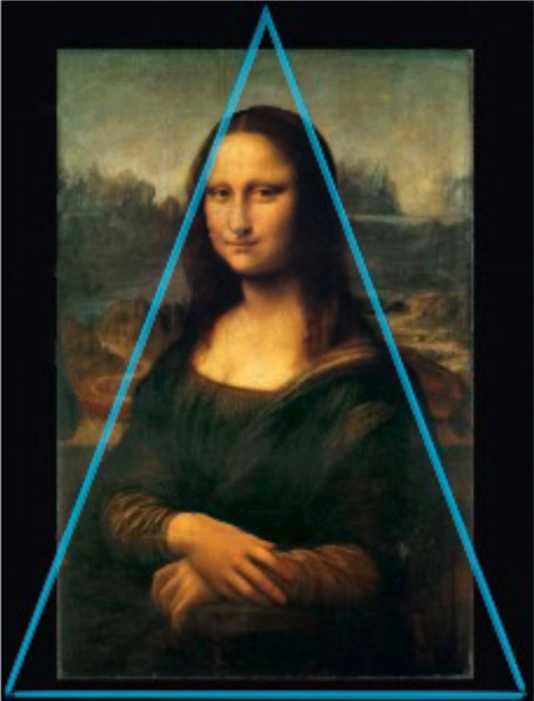 The composition of the Louvre Mona Lisa is closely related to the golden section. First, the golden rectangle and triangle are embedded in the Louvre Mona Lisa. Drawing a rectangle on the surface of the Mona Lisa, the theoretical and effective dimensions of it are similar. Theoretically, 53.14:76.77 is the ratio of the golden rectangle [17]. Compared with the actual wide and length, 53cm and 76.8cm, which is very close to the theoretical golden ratio. As Figure 1 shows, the golden triangle outlined by the blue line is located in the middle of the whole painting [18]. The width and height of this isosceles triangle are the same as the width and length of the golden rectangle, in other words, the proportion of the Mona Lisa was close to both the golden triangle and rectangle ratio.
The composition of the Louvre Mona Lisa is closely related to the golden section. First, the golden rectangle and triangle are embedded in the Louvre Mona Lisa. Drawing a rectangle on the surface of the Mona Lisa, the theoretical and effective dimensions of it are similar. Theoretically, 53.14:76.77 is the ratio of the golden rectangle [17]. Compared with the actual wide and length, 53cm and 76.8cm, which is very close to the theoretical golden ratio. As Figure 1 shows, the golden triangle outlined by the blue line is located in the middle of the whole painting [18]. The width and height of this isosceles triangle are the same as the width and length of the golden rectangle, in other words, the proportion of the Mona Lisa was close to both the golden triangle and rectangle ratio.
Figure 1: Golden triangle in the Mona Lisa, Gyan Bahadur Thapa and Rena Thapa, 2018.
Followed by the golden spiral ratio, which can be represented by placing a square inside the golden rectangle, the remaining rectangle space will be used to form a smaller small golden rectangle. Then, putting another square inside the new golden rectangle, repeat the same operation, ultimately getting a patterning as Figure 2 shown [19]. Next, drawing a quarter circle inside each resulting square, connecting the quarter circle gets together would get a spiral shape, namely the gold spiral. The golden spiral is shown in Figure 3, points 1 to 5 are the golden section points in the golden rectangle they are located at [20]. Each radius of the quarter circle in Figure 3 is the edge of the square in which they are located [21].
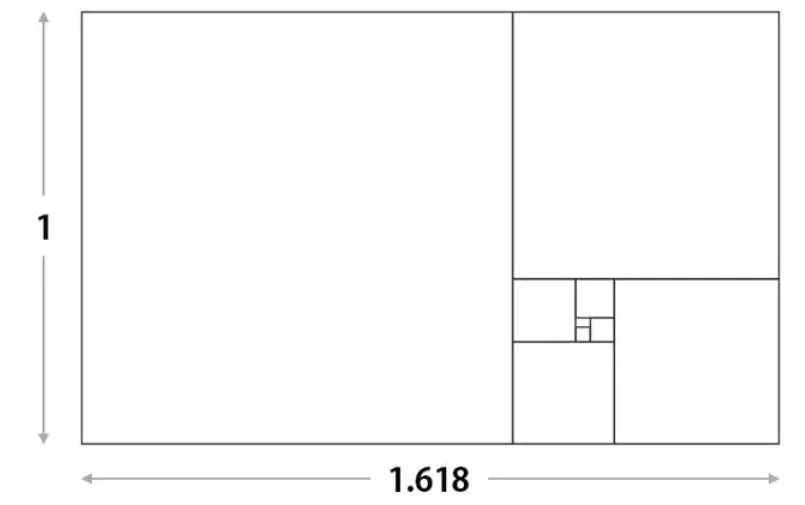
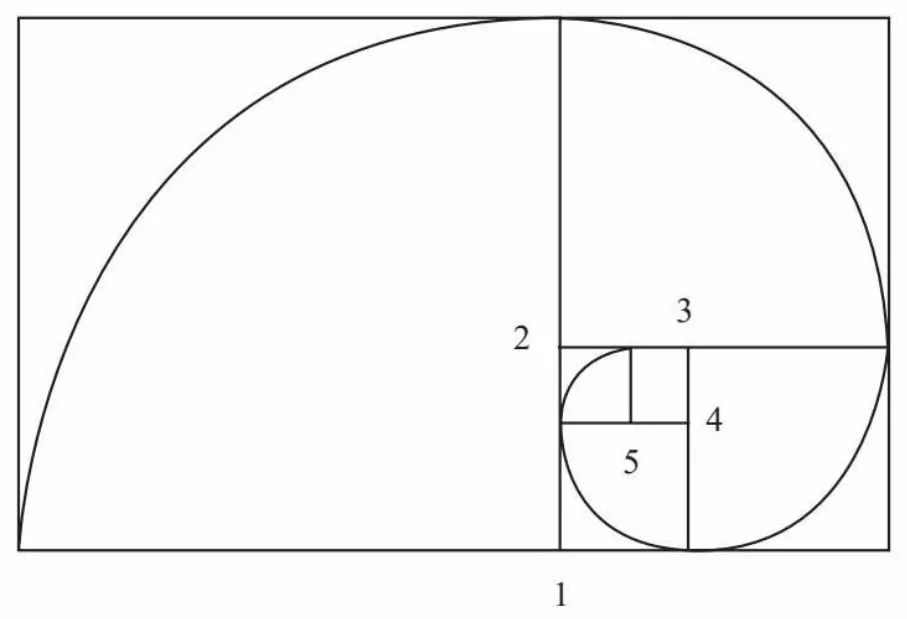 Figure 2: Golden rectangle, Jun-Sheng Duan, Discrete Dynamics in Nature and Society, 2019.
Figure 2: Golden rectangle, Jun-Sheng Duan, Discrete Dynamics in Nature and Society, 2019.
Figure 3: Golden rectangle, Jun-Sheng Duan, Discrete Dynamics in Nature and Society, 2019.
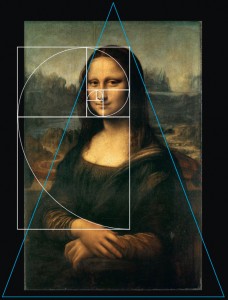 As Figure 4 shows, it can be seen clearly that the spiral shape almost gave a perfect outline for Mona Lisa's face, with the quarter circle of the spiral on the right side of Mona Lisa’s face and the vertical side of the golden rectangle is on the left side [22]. Moreover, the spiral line just started from the tip of Mona Lisa’s nose, grazed the bottom of her chin, the edge of her forehead, all the way to her right arm, and then to the thumb of her left hand, the whole character was surrounded by the golden spiral.
As Figure 4 shows, it can be seen clearly that the spiral shape almost gave a perfect outline for Mona Lisa's face, with the quarter circle of the spiral on the right side of Mona Lisa’s face and the vertical side of the golden rectangle is on the left side [22]. Moreover, the spiral line just started from the tip of Mona Lisa’s nose, grazed the bottom of her chin, the edge of her forehead, all the way to her right arm, and then to the thumb of her left hand, the whole character was surrounded by the golden spiral.
Figure 4: Golden rectangle in Mona Lisa, The Mona Lisa Foundation, 2019.
3.2. Golden ratio in Annunciation
Sandro Botticelli, a pioneer of Italian portraiture, painted the tempera painting on board Annunciation around 1485 [23]. Annunciation is one of the most celebrated artworks in the Robert Lehman Collection and is now preserved in the Metropolitan Museum of Art in New York [24]. This tempera painting was rendered in a classic architectural interior. Botticelli’s Annunciation integrated the golden ratio in its composition of it, it applied a one-point perspective with a vanishing point to express the illusion of depth [25]. Moreover, Botticelli used the scale system of the golden rectangle to set the dimension and composition of his painting. As Figure 5 shows, the size of the Lehman Annunciation is 19.1× 31.4 cm, and the ratio of length and width of this rectangular painting is 0.608, which is very similar to the perfect golden ratio of 0.618 [18].
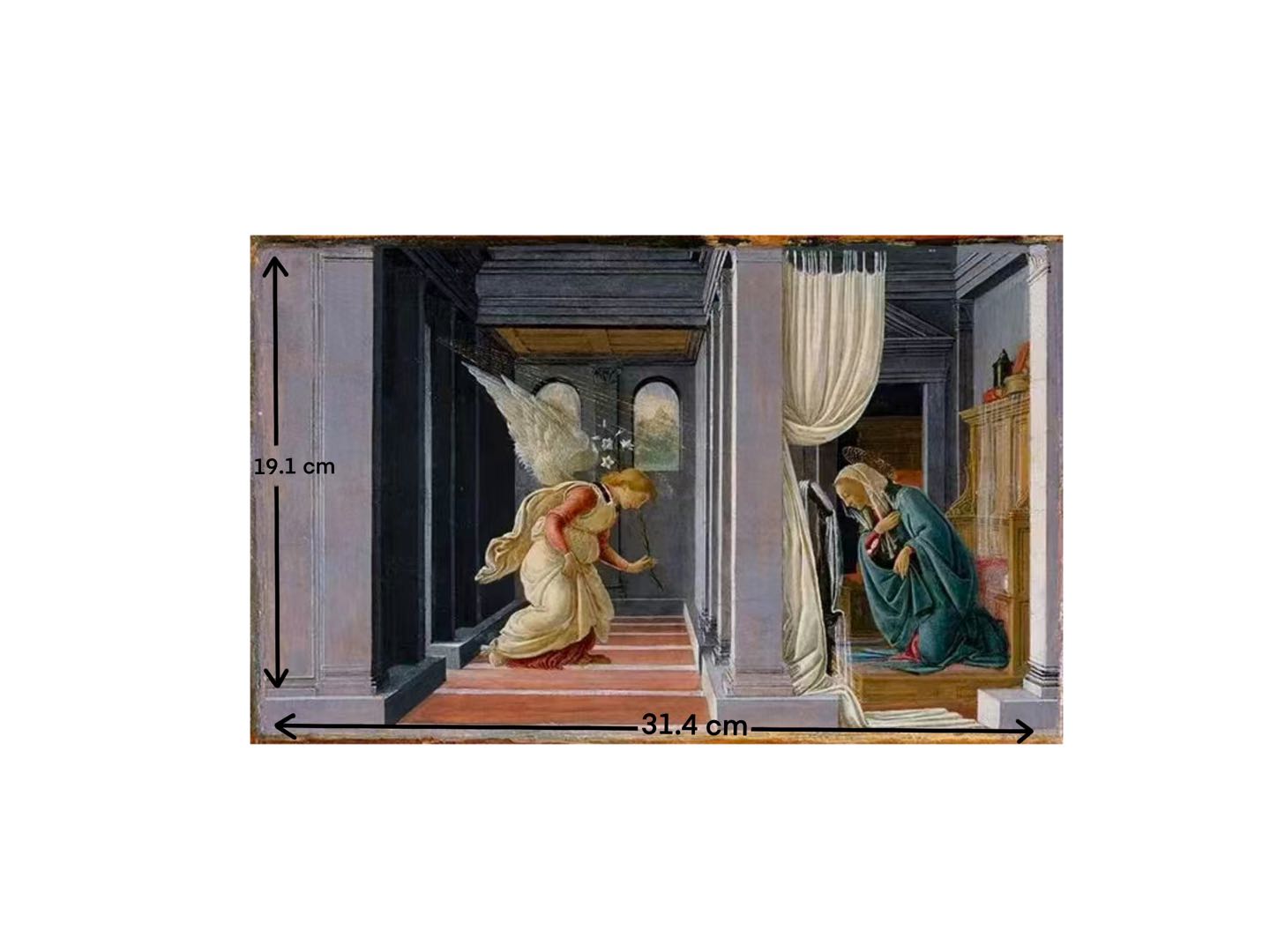
Figure 5: Golden ratio in Annunciation, The Met, no date.
Botticelli's Annunciation pursues a visual balance, showing the beautiful aristocratic courtyard, which is broadened by the accurate use of perspective science. This tempera painting's use of rendering, the relationship between light and dark, and other techniques. As Figure 6 shows, in the left half of the corridor where the angel was, Botticelli applied the composition technique of parallel perspective and one-point perspective, so that the audiences would be conscious of the space between the long shot and close shot and the relationship between them. The audience would see the background outside the corridor through the round-arched window, including the ceiling of the corridor and the wall carvings on the left side of the corridor. Moreover, in terms of proportion, Figure 7 shows the hypotenuse of Angle 123 is right on where the angel's wings are raised, and the hypotenuse of Angle 123 is right on the diagonal of Rectangle 1234, which can be seen when audiences look up at the corridor of the Annunciation. Also, the tempera painting is a large rectangle, and the hypotenuse of Angle 123 at the angel's wings and the hypotenuse that is formed by the woman bend down is just diagonally on the large rectangle, which is shown as the Hypotenuse 14 in Figure 7. These fine-tuned composition proportions pave the solid foundation for the whole painting to present the golden ratio.
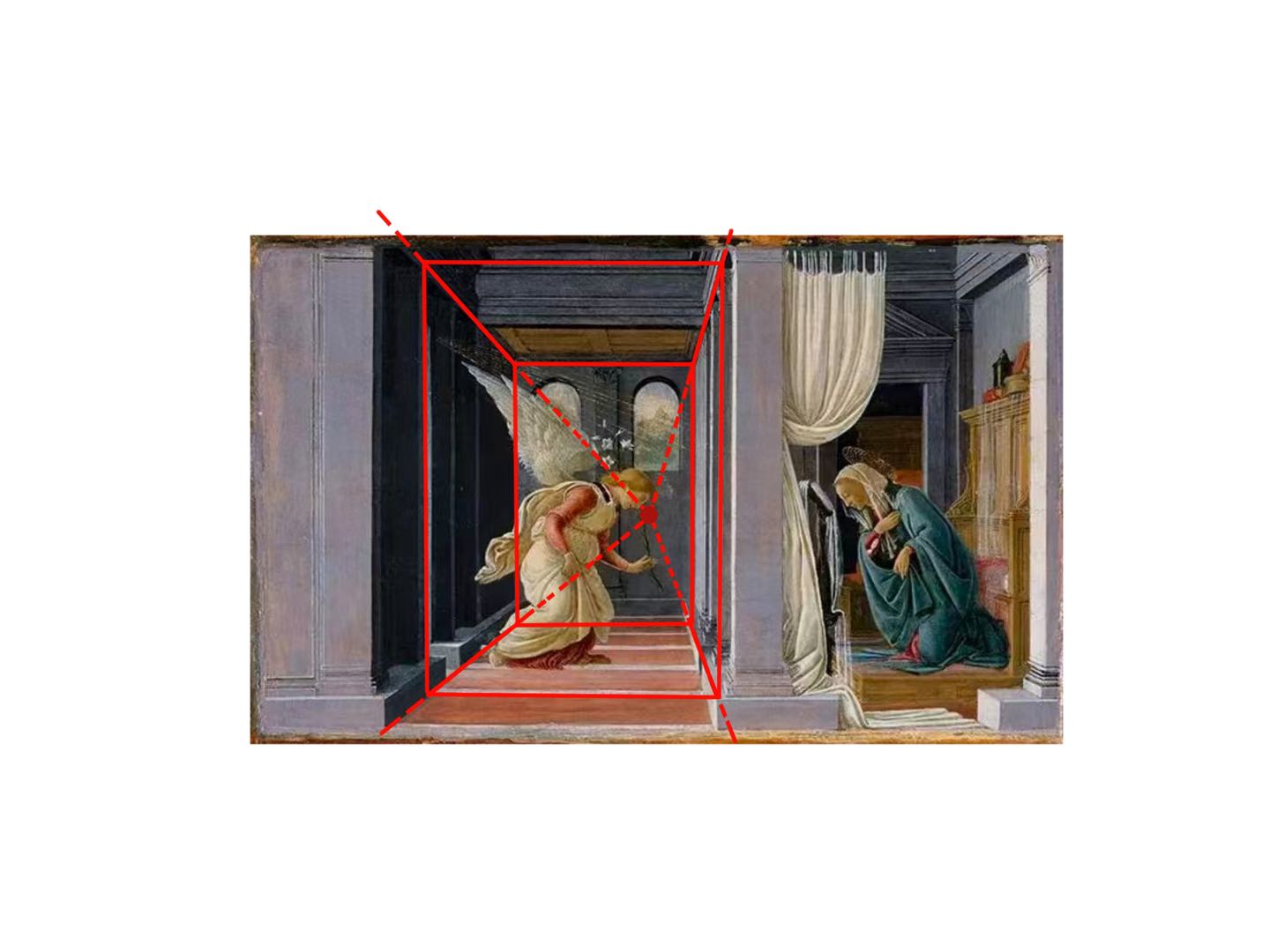
Figure 6: Perspective in Annunciation, Photo credit: Original
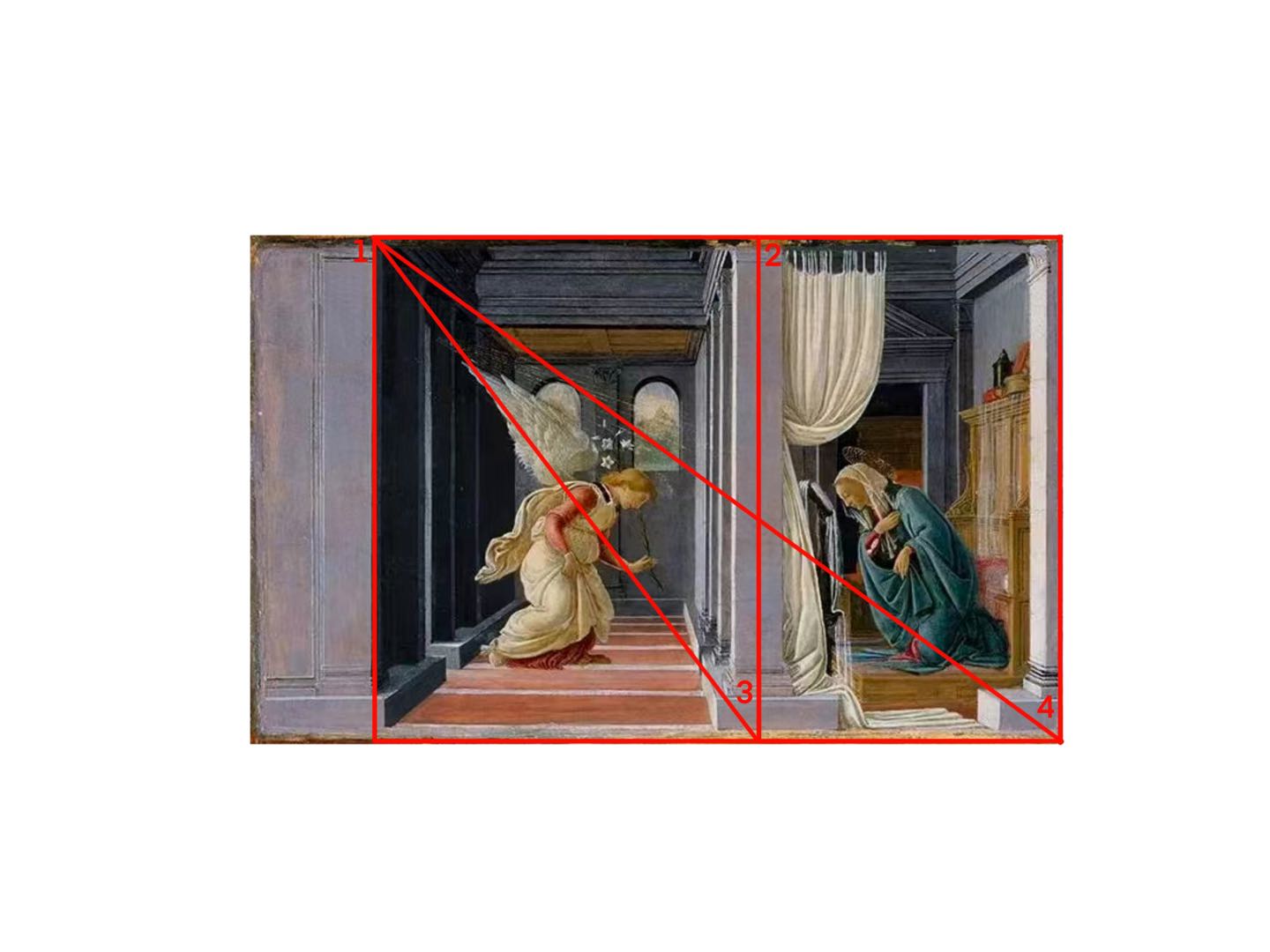
Figure 7: Composition techniques in Annunciation, Photo credit: Original
It is worth noting that Botticelli integrated the geometric proof of the rectangle's dimensions in his Annunciation. To achieve the golden ratio, Botticelli tested the ratio and imply in the Lehman Annunciation [26]. As Figure 8 shows, while creating this painting, Botticelli drew a square ABCD with the same width as the whole Annunciation painting, with a side length of 19.1 cm [18]. Then he divided the square ABCD vertically into two smaller rectangles and get the smaller rectangle EFDC, and drew a diagonal ED in the rectangle EFDC. Using the diagonal ED as a radius, Botticelli drew a quarter circle and get a 31.4cm long rectangle, consummating a golden rectangle. As can be seen in Figure 8, the center line of the wall or bridge pier located at the right of the center of the painting is just on the golden dividing line of the whole painting [18]. While the left corner of the corridor behind the angel corresponds to the vertical building line dividing the square where the angel is in half.

Figure 8: Golden ratio verification of Annunciation, Richard, Artibus et Historiae, 2014.
Arnheim proposed that artists can not only allocate the composition of the described object to take into account the influence of color on the center of the composition but also skillfully arrange the attention center of the picture [27]. To achieve a new force structure, In Annunciation, the geometric proportion that had been theorized to be the most aesthetically pleasing to the eyes was integrated into the painting, so that the painting would reflect the quiet and activity effectively, creating a kind of subtlety and tension of the whole painting.
It is obvious to see that the golden composition proportion, perspective, and a series of mathematical knowledge were constructed and emphasized in the architecture and space in the artwork. By comparison, the Mona Lisa's attainments in picture composition are higher than the Annunciation. Mona Lisa is a portrait of a single person, Leonardo presented the portrayal of Mona Lisa and the distance relationship of the background through golden ratio directly, without any clear moving line of geometry or the emphasis on perspective structure. However, the Annunciation painting needs parallel lines, corridors, floor tiles, windows, and other reference objects to effectively hint at the structural relationship and perspective relationship in the painting.
4. Conclusion
In conclusion, there are many examples of the intersection of art and science, this essay focused on the Louvre Mona Lisa by the art master art in the Renaissance---Leonardo Da Vinci. The essay first emphasized the close relationship between art and science with support from the literature. The Louvre Mona Lisa was a portrait and oil painting painted by Leonardo; the divine proportion of the mathematics involved in many parts of the Mona Lisa. Divine proportion (golden ratio) was created in ancient Greek and prevailed in the Renaissance, it approximately refers to 0.618. There are 4 figures in this essay that verify the golden rectangular, triangle, and spiral are embedded in the Mona Lisa, and certify that the Mona Lisa contains mathematical proportion. The fascinating pictorial effects of the Mona Lisa are strongly associated with the golden section in math, as associated with science. The two figures used to explain the golden proportion in the Annunciation certify the utilization of the golden ratio, the golden ratio of the Annunciation created a comfortable viewing experience for audiences. The aesthetic value of the golden section has gone far beyond the scope of mathematics and art. Many objects in the world are closely related to the golden section. It has formed the law of the world and even the universe, not only the combination of mathematics, art, and architecture, believing in beautiful things can always bring some faith and awe to the world.
References
[1]. Black, Winston. (2019) The Middle Ages: Facts and Fictions. ABC-CLIO.
[2]. Hall, Alfred. (2014) The revolution in science 1500-1750 (New York: Routledge.
[3]. Raphael, Minder. (2013) The Wonders of the Islamic Worlds of Art and Science, Illuminated, New York Times.
[4]. Powers, A. (2020) “Why Art is Vital to the Study of Science”, New York Times, Jul 31, 2020.
[5]. Landau, D., Peter W. (1994) The Renaissance print: 1470-1550. New Haven; London: Yale University Press.
[6]. Sokurov, В. В. (1983) An Introduction to Philosophy in the Renaissance. In Other Words. Translated by Peking University Press. Beijing: Peking University Press.
[7]. Kilroy-Ewbank, L., Graham, H. (2011) A brief introduction on Renaissance, Brewminate frontpage, https://brewminate.com/types-of-patronage-in-renaissance-art-and-architecture/.
[8]. Martin, K. (2011) Leonardo. Oxford University Press; Revised ed. Edition.
[9]. Brooks, S. (2019) The Renaissance (Inside Art Movements). Compass Point Books; Illustrated edition.
[10]. Braida, M., Natali, A., Lorusso, S.(2022) Is the Louvre Mona Lisa Leonardo's second version?: methodological path, historical-bibliographic sources, final judgment. Roma: L’ERMA di BRETSCHNEIDER.
[11]. Carlson, SC. (2022) “golden ratio.” Accessed on September 3, 2022. https://www.britannica.com/science/golden-ratio.
[12]. Green, C. (1995) Psychological Research on the Aesthetics of the Golden Section. Perception 24, no. 8, PubMed.
[13]. Lichfield, J. (2005) "The Moving of the Mona Lisa." The Independent, Accessed on September 3, 2022, https://www.independent.co.uk/news/world/europe/the-moving-of-the-mona-lisa-530771.html.
[14]. Rama, Kundu., Pradip Kumar, Dey., Santwana, Haldar., Tanuka, Das., Asit Kumar, Biswas, Jayanta, Bhattacharya., Pradipta, Sengupta. Widening horizons: essays in honor of [Professor] Mohit K. Ray. New Delhi: Sarup & Sons, 2005. Google Book.
[15]. The Mona Lisa Foundation. “Leonardo and Mathematics.” Accessed August 12, 2022. https://monalisa.org/2012/09/12/leonardo-and-mathematics-in-his-paintings/.
[16]. Vadachkoriia NR, Gumberidze NSW, Mandzhavidze NA. "["Golden proportion" and its application to calculate dentition]." Georgian Medical News, Jan 01, 2007. PMID:17327645.
[17]. Lüttge, Ulrich, and Gustavo M. Souza. "The Golden Section and beauty in nature: The perfection of symmetry and the charm of asymmetry." Progress in biophysics and molecular biology 146, (September 2019): 98-103. https://www.sciencedirect.com/science/article/abs/pii/S0079610718302128.
[18]. Meisner, Gary B. The Golden Ratio: The Divine Beauty of Mathematics. New York: Race Point Publishing, 2018. Google Book.
[19]. Kulski, Jerzy K. Leonardo Da Vinci and the Pacioli Code: Who was Fra Luca Pacioli? ISBN Bowker Kulski: International Standard Book Number, 2019.
[20]. Mario, Livio. “The golden ratio and aesthetics.” Plus Magazine, November 1, 2002. https://plus.maths.org/issue22/features/golden/feat.pdf.
[21]. Irene, Plonczak. and Susan, Goefz Zwirn. “Understanding the Art in Science and the Science in Art through Crosscutting Concepts.” Science Scope Science Scope 38, no. 7 (MARCH 2015): 57-63. https://www.jstor.org/stable/43691253.
[22]. Thapa, Gyan Bahadur. and Thapa, Rena., "The relation of the golden ratio, Mathematics, and aesthetics," Journal of the Institute of Engineering 14, no. 1 (August 2018): 188–199. Figure 1, https://doi.org/10.3126/jie.v14i1.20084.
[23]. Jun-Sheng Duan, “Shrinkage Points of Golden Rectangle, Fibonacci Spirals, and Golden Spirals.” Discrete Dynamics in Nature and Society 2019, (2019). https://doi.org/10.1155/2019/3149602.
[24]. The Met. “The Annunciation.” Accessed September 3, 2022. https://www.metmuseum.org/art/collection/search/459016.
[25]. Jones, Christopher. P. “How to Read Paintings: The Annunciation by Botticelli." Published in February 2021 at the Medium. https://christopherpjones.medium.com/how-to-read-paintings-the-annunciation-by-botticelli-f5a3ae1ea902.
[26]. Richard, Stapleford. “Botticelli and the Golden Section in the Lehman "Annunciation".” Artibus et Historiae 35, no. 69 (2014): 35-51. IRSA s.c.
[27]. Rudolf, Arnheim. Art and Visual Perception: A Psychology of the Creative Eye. California: University of California Press, 1966. Google Book.
Cite this article
Liu,R. (2023). The Golden Ration in the Renaissance Art: A Comparative Study on the Geometrical Layout of the Mona Lisa and the Annunciation. Communications in Humanities Research,3,316-323.
Data availability
The datasets used and/or analyzed during the current study will be available from the authors upon reasonable request.
Disclaimer/Publisher's Note
The statements, opinions and data contained in all publications are solely those of the individual author(s) and contributor(s) and not of EWA Publishing and/or the editor(s). EWA Publishing and/or the editor(s) disclaim responsibility for any injury to people or property resulting from any ideas, methods, instructions or products referred to in the content.
About volume
Volume title: Proceedings of the International Conference on Interdisciplinary Humanities and Communication Studies (ICIHCS 2022), Part 1
© 2024 by the author(s). Licensee EWA Publishing, Oxford, UK. This article is an open access article distributed under the terms and
conditions of the Creative Commons Attribution (CC BY) license. Authors who
publish this series agree to the following terms:
1. Authors retain copyright and grant the series right of first publication with the work simultaneously licensed under a Creative Commons
Attribution License that allows others to share the work with an acknowledgment of the work's authorship and initial publication in this
series.
2. Authors are able to enter into separate, additional contractual arrangements for the non-exclusive distribution of the series's published
version of the work (e.g., post it to an institutional repository or publish it in a book), with an acknowledgment of its initial
publication in this series.
3. Authors are permitted and encouraged to post their work online (e.g., in institutional repositories or on their website) prior to and
during the submission process, as it can lead to productive exchanges, as well as earlier and greater citation of published work (See
Open access policy for details).
References
[1]. Black, Winston. (2019) The Middle Ages: Facts and Fictions. ABC-CLIO.
[2]. Hall, Alfred. (2014) The revolution in science 1500-1750 (New York: Routledge.
[3]. Raphael, Minder. (2013) The Wonders of the Islamic Worlds of Art and Science, Illuminated, New York Times.
[4]. Powers, A. (2020) “Why Art is Vital to the Study of Science”, New York Times, Jul 31, 2020.
[5]. Landau, D., Peter W. (1994) The Renaissance print: 1470-1550. New Haven; London: Yale University Press.
[6]. Sokurov, В. В. (1983) An Introduction to Philosophy in the Renaissance. In Other Words. Translated by Peking University Press. Beijing: Peking University Press.
[7]. Kilroy-Ewbank, L., Graham, H. (2011) A brief introduction on Renaissance, Brewminate frontpage, https://brewminate.com/types-of-patronage-in-renaissance-art-and-architecture/.
[8]. Martin, K. (2011) Leonardo. Oxford University Press; Revised ed. Edition.
[9]. Brooks, S. (2019) The Renaissance (Inside Art Movements). Compass Point Books; Illustrated edition.
[10]. Braida, M., Natali, A., Lorusso, S.(2022) Is the Louvre Mona Lisa Leonardo's second version?: methodological path, historical-bibliographic sources, final judgment. Roma: L’ERMA di BRETSCHNEIDER.
[11]. Carlson, SC. (2022) “golden ratio.” Accessed on September 3, 2022. https://www.britannica.com/science/golden-ratio.
[12]. Green, C. (1995) Psychological Research on the Aesthetics of the Golden Section. Perception 24, no. 8, PubMed.
[13]. Lichfield, J. (2005) "The Moving of the Mona Lisa." The Independent, Accessed on September 3, 2022, https://www.independent.co.uk/news/world/europe/the-moving-of-the-mona-lisa-530771.html.
[14]. Rama, Kundu., Pradip Kumar, Dey., Santwana, Haldar., Tanuka, Das., Asit Kumar, Biswas, Jayanta, Bhattacharya., Pradipta, Sengupta. Widening horizons: essays in honor of [Professor] Mohit K. Ray. New Delhi: Sarup & Sons, 2005. Google Book.
[15]. The Mona Lisa Foundation. “Leonardo and Mathematics.” Accessed August 12, 2022. https://monalisa.org/2012/09/12/leonardo-and-mathematics-in-his-paintings/.
[16]. Vadachkoriia NR, Gumberidze NSW, Mandzhavidze NA. "["Golden proportion" and its application to calculate dentition]." Georgian Medical News, Jan 01, 2007. PMID:17327645.
[17]. Lüttge, Ulrich, and Gustavo M. Souza. "The Golden Section and beauty in nature: The perfection of symmetry and the charm of asymmetry." Progress in biophysics and molecular biology 146, (September 2019): 98-103. https://www.sciencedirect.com/science/article/abs/pii/S0079610718302128.
[18]. Meisner, Gary B. The Golden Ratio: The Divine Beauty of Mathematics. New York: Race Point Publishing, 2018. Google Book.
[19]. Kulski, Jerzy K. Leonardo Da Vinci and the Pacioli Code: Who was Fra Luca Pacioli? ISBN Bowker Kulski: International Standard Book Number, 2019.
[20]. Mario, Livio. “The golden ratio and aesthetics.” Plus Magazine, November 1, 2002. https://plus.maths.org/issue22/features/golden/feat.pdf.
[21]. Irene, Plonczak. and Susan, Goefz Zwirn. “Understanding the Art in Science and the Science in Art through Crosscutting Concepts.” Science Scope Science Scope 38, no. 7 (MARCH 2015): 57-63. https://www.jstor.org/stable/43691253.
[22]. Thapa, Gyan Bahadur. and Thapa, Rena., "The relation of the golden ratio, Mathematics, and aesthetics," Journal of the Institute of Engineering 14, no. 1 (August 2018): 188–199. Figure 1, https://doi.org/10.3126/jie.v14i1.20084.
[23]. Jun-Sheng Duan, “Shrinkage Points of Golden Rectangle, Fibonacci Spirals, and Golden Spirals.” Discrete Dynamics in Nature and Society 2019, (2019). https://doi.org/10.1155/2019/3149602.
[24]. The Met. “The Annunciation.” Accessed September 3, 2022. https://www.metmuseum.org/art/collection/search/459016.
[25]. Jones, Christopher. P. “How to Read Paintings: The Annunciation by Botticelli." Published in February 2021 at the Medium. https://christopherpjones.medium.com/how-to-read-paintings-the-annunciation-by-botticelli-f5a3ae1ea902.
[26]. Richard, Stapleford. “Botticelli and the Golden Section in the Lehman "Annunciation".” Artibus et Historiae 35, no. 69 (2014): 35-51. IRSA s.c.
[27]. Rudolf, Arnheim. Art and Visual Perception: A Psychology of the Creative Eye. California: University of California Press, 1966. Google Book.









